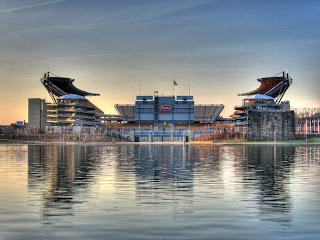 Until ten years ago, Three Rivers Stadium was the home of one of the most successful teams in the NFL.
Until ten years ago, Three Rivers Stadium was the home of one of the most successful teams in the NFL.What NFL team has won six Superbowl titles, eight AFC Championship Games and played in fifteen conference championship games, more than any other AFC or NFC team? This team shares with the Dallas Cowboys the record for most Super Bowl appearances.
If you guessed the Pittsburgh Steelers, you are right. Named for the city that is known for its many bridges and former steel manufacturing, the Pittsburgh Steelers have a huge fan base named best in the NFL largely because of 299 consecutive sold-out games.

 Now the Steelers play at Heinz Field. (Does the Heinz name ring a bell? For what is this family known?)
Now the Steelers play at Heinz Field. (Does the Heinz name ring a bell? For what is this family known?)So, what does steel have to do with Pittsburgh? Look at the three photographs below. Each depicts the same geographic location. Examine the first picture closely. What do you see? What does it say about the economy of Pittsburgh in the past? What is happening in the second picture? How does it show a changing economy? Consider the third photograph. Can you see that it illustrates a new use for the land? Now a shopping district with many stores and restaurants, the area provides goods and services where consumers can spend their money.
 This is a Pittsburgh steel mill with smoke stacks belching. Thousands and thousands of workers were employed here. The mill stayed so busy producing steel for automobiles and construction goods that three shifts of workers toiled around the clock. The factory operated for decades, and people relied on the income derived from working there.
This is a Pittsburgh steel mill with smoke stacks belching. Thousands and thousands of workers were employed here. The mill stayed so busy producing steel for automobiles and construction goods that three shifts of workers toiled around the clock. The factory operated for decades, and people relied on the income derived from working there. 
In the 1980s the steel industry collapsed, and the steel mill closed. It was cheaper to produce steel in other countries. Jobs shifted overseas and foreign workers took over the creation of steel. The steel mill on this site was torn down but the large smoke stacks were preserved. You can see them to the left of the photograph. The smokestacks now serve a new purpose, to remind people that at one time in Pittsburgh steel was king.
 In the 1990s, the area was reclaimed for a new purpose. It now houses a large shopping district with a multitude of stores and restaurants. The smoke stacks are still there. Which photo do you believe illustrates the most job opportunities? Why? What happens to a community when its economic base collapses? Is the economic base in your community changing? If so, how?
In the 1990s, the area was reclaimed for a new purpose. It now houses a large shopping district with a multitude of stores and restaurants. The smoke stacks are still there. Which photo do you believe illustrates the most job opportunities? Why? What happens to a community when its economic base collapses? Is the economic base in your community changing? If so, how?When European settlers established communities in the 1600s, the quickest transportation was by water. Because of this many cities across America grew up on rivers. Pittsburgh is one such city. Established where the Monongahela and Allegheny Rivers join to form the Ohio River, Pittsburgh has a long and important history. In the early days, Fort Pitt, constructed during the French and Indian War, sat at the tip of a triangular piece of land bordering the confluence of the two rivers. All that remains today is the Block House, constructed by the British in 1764. Native tribes tried to reclaim lands taken from them by Europeans but were unsuccessful.
 The Block House served as a redoubt for Ft. Pitt.
The Block House served as a redoubt for Ft. Pitt.Today Pittsburgh bustles with activity. Its economy is largely based on healthcare, technology, education, robotics, and financial services. Long gone are most of the steel mills for which the city was widely known. There is a mix of new architecture among the old. The photographs below illustrate this and also show a few sights one can see while strolling along the city streets.







No comments:
Post a Comment